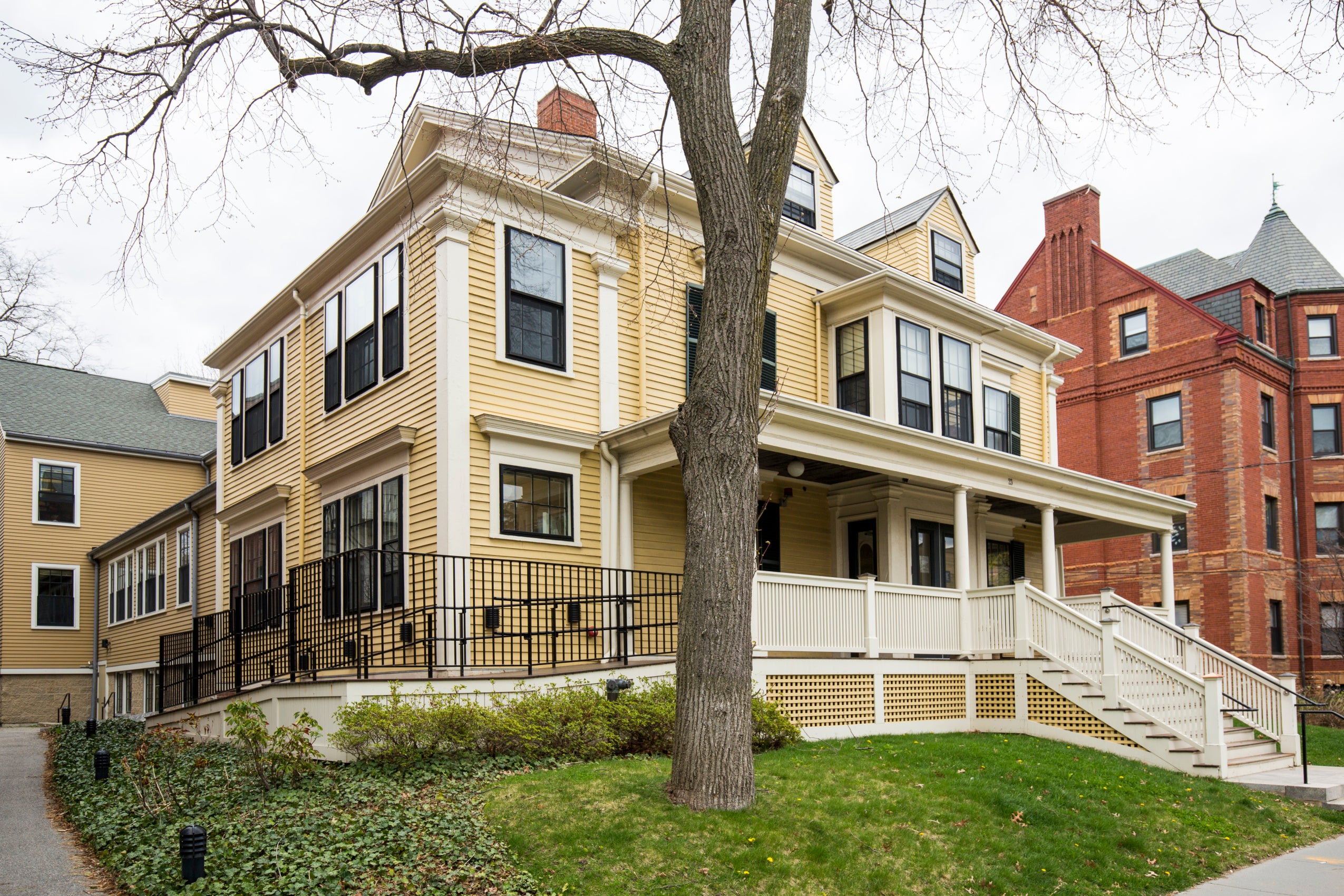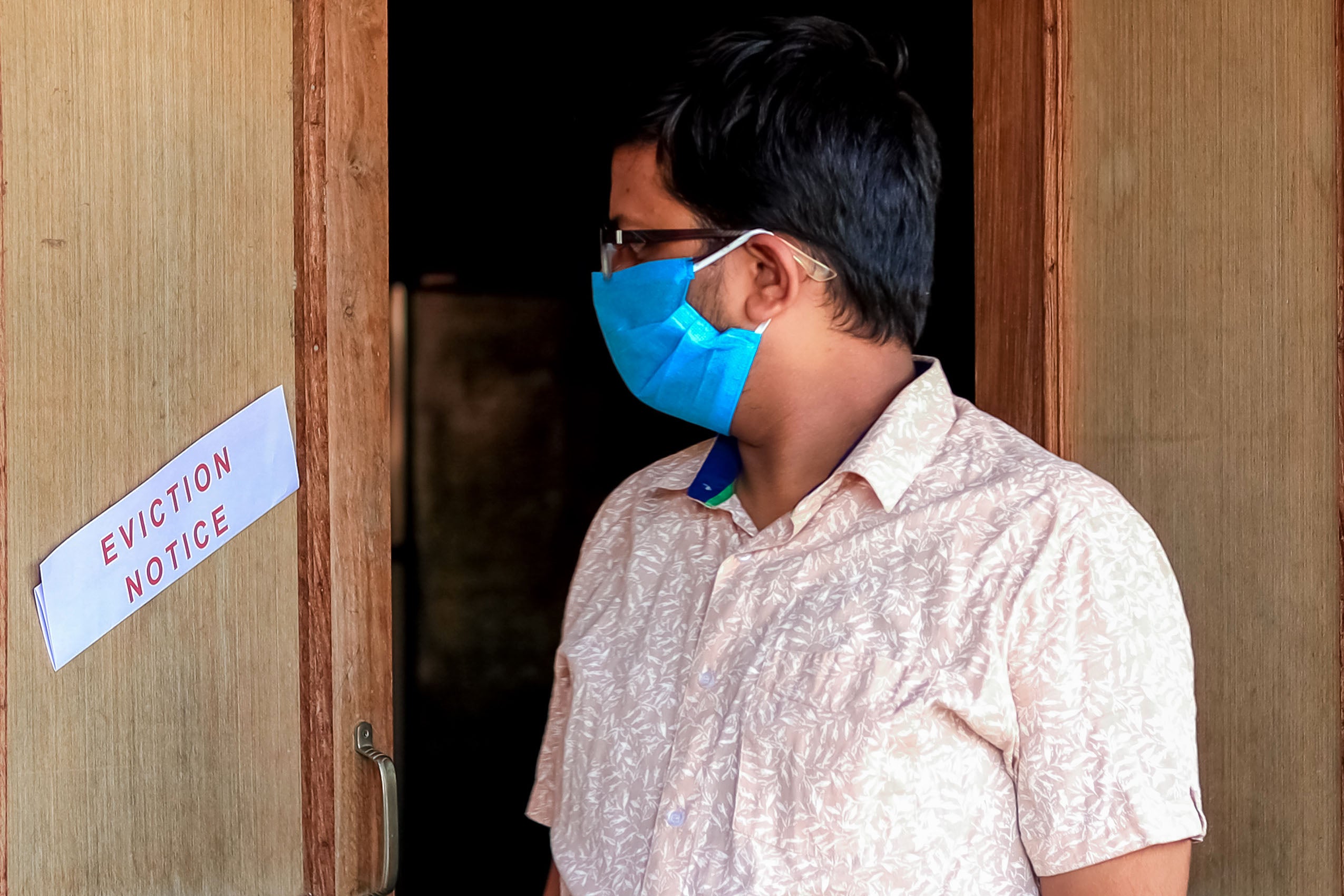In September, the Centers for Disease Control and Prevention (CDC) issued a directive temporarily halting residential evictions in an effort to slow the spread of COVID-19. It is set to expire on Dec. 31. A bipartisan economic relief package being debated in Congress is said to include a one-month extension. Advocates hope that, if approved, lawmakers will pass additional rental assistance in January before the moratorium expires again.
Harvard Law Today recently reached out via email to Kiah Duggins ’21 and Sam Gilman ’22, members of the Harvard Legal Aid Bureau (HLAB) at Harvard Law School, about the CDC eviction moratorium, protections for renters, and their work on housing issues, locally and nationally. HLAB is the nation’s oldest student-run legal aid organization and has a long history of responding to the legal needs of low-income people in the greater Boston area. Duggins is the president of HLAB and a student attorney in its housing practice. Gilman is a new member and a co-founder of the Colorado-based COVID-19 Eviction Defense Project.
HLT: Upwards of 40 million people could face eviction when the CDC’s national eviction moratorium expires on Dec. 31. What happens on Jan. 1?
Kiah Duggins and Sam Gilman: The United States is facing a tsunami of evictions that disproportionately impacts Black and brown households and families with children. The CDC moratorium has played an important role in reducing evictions this fall, and its extension is critical to keeping renters housed.
Tenants should know that only a judge can evict them. They have the right to stay and fight for their homes.
The scope of this humanitarian crisis is enormous. According to the COVID-19 Eviction Defense Project’s tabulations of recent Census Bureau data, 16.5 million renters live in 7 million households that are already behind on rent. Nearly 1 in 3 Black renters, 1 in 6 Latinx renters, and 1 in 5 families with children are behind on rent. Each of these households could be at risk of losing their homes due to non-payment evictions as soon as Jan. 4. Many could be at risk now if they do not affirmatively declare that they are protected by the CDC moratorium during the legal process. Others are at risk of displacement due to informal evictions that occur outside of the legal system. To make matters worse, millions continue to miss rent each month, deepening arrearages and increasing the likelihood of displacement.
In the Boston metropolitan area, 14% of renters are behind on rent. Since the state moratorium lifted in October, eviction filing rates have returned to pre-pandemic levels despite the largest landlords in Boston agreeing not to file until 2021, stays while tenants wait on rental assistance, and a backlog of cases waiting for the expiration of notices to quit. These figures highlight the fact that the CDC moratorium does not prevent landlords from filing or pursuing evictions. It only guarantees a halt to executions for tenants who affirmatively declare that they are protected.
In normal times, an eviction has a catastrophic effect on a family, often leading to homelessness, negative health outcomes, and even deaths of despair. During the pandemic, the eviction tsunami is making landfall during the out-of-control spread of the deadly disease in the middle of winter. Indeed, recent research has already associated the lifting of eviction moratoria this summer with more than 10,000 COVID deaths.
In Massachusetts, there are enhanced efforts at eviction diversion through rental assistance and mediation. And tenants should know their rights in summary process proceedings. Tenants have the right to a jury trial, and they can only be physically removed from their homes with a document called a “Writ of Execution” that’s signed by a judge. Tenants should only receive signed execution documents if they lost their trial, they didn’t show up to their trial, or they breached a settlement agreement. The CDC moratorium’s expiration on Jan. 1 will allow the police to obtain execution documents signed by judges to physically remove tenants and their belongings from their homes.
HLT: If the moratorium isn’t extended, are there other protections in place for renters?
Duggins and Gilman: Other protections are in place, through each state’s summary eviction process and various state and local eviction laws. There is wide discrepancy in moratoria and in the ability of state summary process law to help keep renters housed. While a very basic summary process exists, absent eviction moratoria or the receipt of rent relief, most renters face the prospect of disruptive displacement. In Massachusetts protections include:
- Renters have a right to a jury trial and often an opportunity to try court-sponsored mediation, and they legally do not have to leave their homes until a police officer presents them with a “Writ of Execution” that is signed by a judge.
- As soon as renters receive a summons and complaint—after the expiration of their 14- or 30-day eviction notice (called a “Notice to Quit”) they have the right to request a jury trial, tell their side of the story by mailing Answer and Discovery documents to the court and their landlord. Those documents can be found here.
- Tenants also have the opportunity to attend a virtual mediation to try to reach an agreement with their landlord or apply for rental assistance through Residential Assistance for Families in Transition (RAFT). Both of these programs have been expanded in an attempt to respond to the crisis. These programs have struggled to keep pace with the demand. There have been significant delays in RAFT processing, and the $10,000 available to renters only covers 4-5 months of rent in Boston for many families.
- Tenants also have the right to form tenant associations with other tenants in their building, and to attend tenant organizing meetings. HLAB’s community partner City Life/Vida Urbana helps tenants get organized and learn about their rights at 6:30 p.m. every Tuesday and Wednesday.
HLT: If the moratorium is extended, tenants will still owe past rent to landlords. Potentially tens of thousands of dollars, per tenant. How can the government address this issue for both tenants and landlords?
Duggins and Gilman: Extending the eviction moratorium is necessary to keep tenants housed in the pandemic, and it must be coupled with accessible rental assistance to help stabilize tenancies into the future. Moody’s Analytics has estimated that rental debts could reach $70 billion by the end of the year.
These rental arrearages also create long-term financial problems for small mom-and-pop landlords who are own a disproportionate percentage of naturally occurring affordable housing. Rental payments, of course, ensure that mom-and-pop landlords can pay their mortgages. Without these funds, we could see a rush of foreclosures, increasing consolidation of the rental housing market, which in turn may lead to more evictions. According to a study from the Atlanta Federal Reserve, institutionally owned and managed properties tend to be the most aggressive evictors.
In addition to federal rental assistance proposals pending in the stimulus negotiations, Massachusetts legislators have offered the Guaranteed Housing Stability Act (H.5018) to advance these goals. The act, pending before the legislature, guarantees stability for tenants by ensuring that individuals cannot lose their homes as a result of lost income during the pandemic and provides rental and mortgage relief for small landlords and homeowners who are also struggling.

HLT: What work have students in the Harvard Legal Aid Bureau and the COVID-19 Eviction Defense Project been doing related to housing issues?
Duggins and Gilman: HLAB has been working with City Life/Vida Urbana, Springfield No One Leaves, and the Homes for All Coalition to pass the Guaranteed Housing Stability Act, H.5018, which protects tenants, homeowners, and small landlords. We have also been litigating dozens of eviction defense cases in court and holding an Eviction Clinic every week to help unrepresented tenants prepare court documents. Two nights per week, HLAB members work with people facing housing insecurity at City Life/Vida Urbana meetings. And, HLAB members offer “Lawyer for the Day” services via Zoom to unrepresented litigants in Eastern Housing Court.
At the COVID-19 Eviction Defense Project, [Gilman and his colleagues] have been using data and storytelling to frame the stakes of the eviction crisis. They have also organized a team of volunteer lawyers to provide legal guidance to renters, and launched a rental assistance fund designed to pilot new models to make rental assistance delivery more accessible. To date, their analysis of eviction risk was published in partnership with the Aspen Institute and cited by the CDC moratoria. The project has additional analyses forthcoming on the return of investment of pandemic-related rental assistance and best practices for rental assistance distribution.
HLT: Anything else you’d like to add?
Duggins and Gilman: We want to highlight two things: First, tenants should know that only a judge can evict them. They have the right to stay and fight for their homes. If tenants [in the Boston area] need help knowing what to do next, they should reach out to City Life/Vida Urbana at (617) 934-5006 (English) or (617) 397-3773 (Spanish). Tenants and low-income owner-occupants [in Massachusetts] needing legal assistance can also visit the COVID Eviction Legal Help Project.
Second, we want to emphasize that laws like eviction moratoria and legal assistance play an important role in keeping renters housed. In addition, we desperately need a comprehensive solution that combines legal protections with billions in rental assistance funding and other household-stabilizing mechanisms like rent deferrals. Ultimately, large-scale government intervention is necessary to prevent a humanitarian crisis in January.
